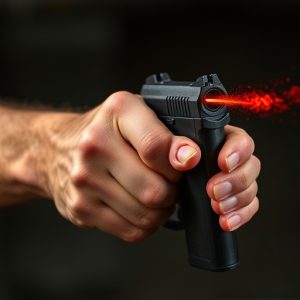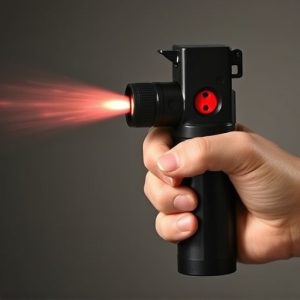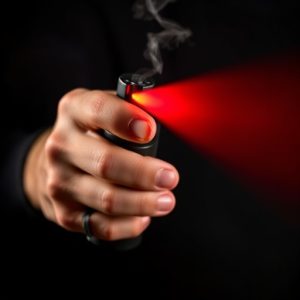Pepper Spray Defense: Composition, Impact, Duration & Legalities
Pepper spray, utilizing capsaicin from chili peppers, effectively deters and defends against assaila…….
Pepper spray, utilizing capsaicin from chili peppers, effectively deters and defends against assailants by causing temporary disorientation and discomfort through eye irritation, coughing, and breathing difficulties. The effects last 20-60 minutes, depending on concentration, allowing users to escape or wait for help. Understanding legalities, proper usage techniques, and environmental factors is crucial for maximizing its deterrent effect as a last resort defense tool.
“Discover the power of pepper spray as a personal defense mechanism. This comprehensive guide explores its inner workings, from the chemical composition that creates a disabling effect on attackers, to the physiological impact and duration of its effectiveness.
We’ll delve into legal considerations and best practices, ensuring you understand the factors influencing pepper spray’s lifespan and how to use it responsibly. Uncover why this non-lethal option is a game-changer for personal safety, especially when considering how long pepper spray effects last.”
- Understanding Pepper Spray: Chemical Composition and Activation
- The Physiological Impact of Pepper Spray: How it Disables Attackers
- Duration of Effectiveness: Factors Influencing Pepper Spray's Lifespan
- Legal Considerations and Best Practices for Using Pepper Spray as a Defense Mechanism
Understanding Pepper Spray: Chemical Composition and Activation
Pepper spray, a powerful deterrent and defense mechanism, is a compound designed to cause temporary disorientation and discomfort in potential assailants. Its active ingredient, capsaicin, is derived from chili peppers and is known for its pungent and irritating properties. When deployed, pepper spray creates a cloud of fine mist containing this chemical, which activates when it comes into contact with the eyes, skin, or respiratory system.
The effects of pepper spray can last for several minutes, typically ranging from 20 to 60 minutes, depending on the concentration and application method. During this period, individuals affected experience teary eyes, difficulty breathing, coughing, and a strong burning sensation in the nose and throat. This temporary but intense disruption can provide valuable time for escape or the arrival of assistance, making pepper spray a popular choice for personal defense and law enforcement strategies.
The Physiological Impact of Pepper Spray: How it Disables Attackers
Pepper spray is a powerful deterrent and defense mechanism that relies on irritating the attacker’s eyes, nose, and respiratory system. When deployed, it rapidly fills the immediate area with a spicy, burning sensation. The active ingredient, capsaicin, triggers nerve endings, causing an intense but temporary response. This leads to temporary blindness, coughing, and difficulty breathing in the target, giving the user precious time to escape or fight back.
The physiological impact of pepper spray is rapid yet fleeting. The effects typically last between 20 minutes and an hour, depending on the concentration and amount used. During this period, the attacker may experience severe discomfort, making it challenging to continue any aggressive behavior. However, once the spray dissipates, symptoms usually subside, leaving no long-term harm but a powerful reminder for potential assailants.
Duration of Effectiveness: Factors Influencing Pepper Spray's Lifespan
The duration of a pepper spray’s effectiveness can vary greatly depending on several factors. One key influencer is environmental conditions, such as temperature and humidity; extreme heat or moist environments can cause the spray to evaporate faster. Another significant factor is the quality and potency of the spray itself—higher-quality products are designed to withstand environmental stress longer. Distance also plays a role; pepper spray is typically most effective when used in close proximity to the target, with its effects diminishing as distance increases. Additionally, individual factors like breathing patterns can affect how long someone remains incapacitated after being sprayed.
Understanding these variables is crucial for users to make informed decisions about when and where to deploy pepper spray for self-defense. Proper storage, maintaining the product in optimal conditions, and staying aware of its range and potency are essential considerations to maximize its effectiveness as a deterrent.
Legal Considerations and Best Practices for Using Pepper Spray as a Defense Mechanism
Using pepper spray as a defense mechanism comes with its own set of legal considerations and best practices that must be understood to ensure safety and accountability. It’s crucial to recognize that laws regarding pepper spray vary significantly from one jurisdiction to another, with some regions allowing its use only by law enforcement while others permit it for personal protection. Always check local legislation before acquiring pepper spray, as unauthorized possession or misuse could lead to legal consequences.
Best practices dictate that individuals carrying pepper spray should be trained in its proper use, including understanding how long pepper spray effects last. Typically, the impact can last from 20 seconds to several minutes, during which time the target becomes temporarily incapacitate due to irritation of the eyes, respiratory system, and skin. However, this duration can vary based on factors like the concentration of capsaicin (the active ingredient), weather conditions, and the target’s fitness level. It’s recommended to use pepper spray only as a last resort and to maintain a safe distance from the attacker, allowing time for law enforcement to arrive if necessary.
Pepper spray, with its potent chemical composition, serves as an effective personal defense mechanism. By understanding its activation, physiological impact on attackers, and the factors influencing its duration of effectiveness (including how long pepper spray effects last), individuals can make informed decisions in potentially dangerous situations. While legal considerations vary by region, responsible use of pepper spray can be a crucial tool for self-defense when combined with proper training and best practices.


